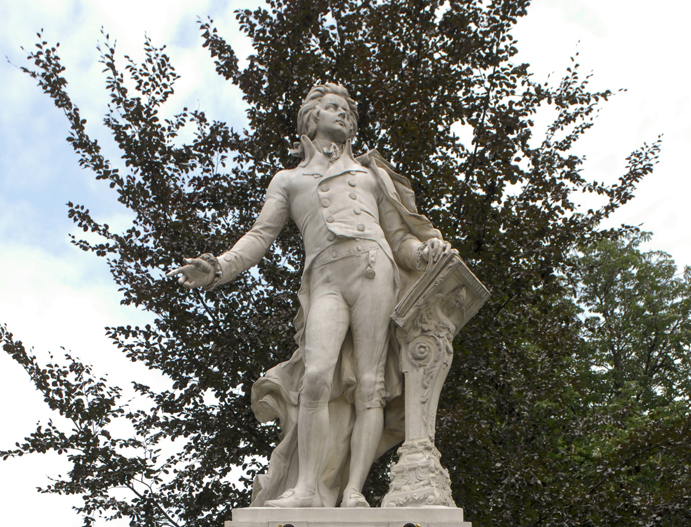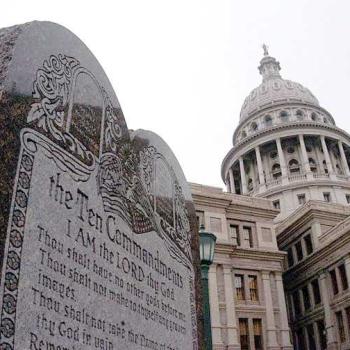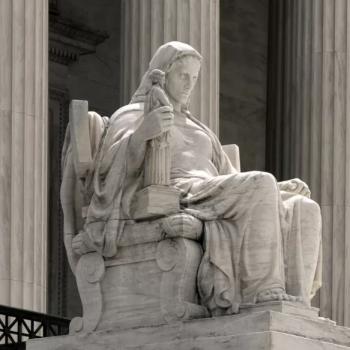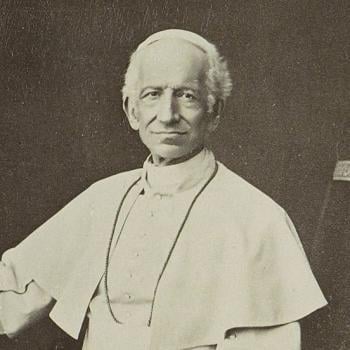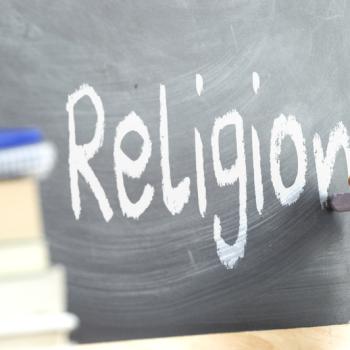The 1984 film Amadeus — and the stage play on which it was based — took liberties with history, including the story behind the composition of the Mozart Requiem in D Minor. But the real story is just as dramatic and is the stuff of legend — and wild conspiracy theories. So let’s try to sort fact from fiction.
The year was 1791, and the young Austrian composer Wolfgang Mozart was enjoying a prolific period. That year he completed two operas. One was Die Zauberflöte (The Magic Flute), to be performed at a theater owned by the librettist, Emanuel Schikaneder. The other opera was La clemenza di Tito (The Clemency of Titus), which had been commissioned by the court of the Emperor Leopold II. In 1791 Mozart also composed several other of his most popular works, including the Clarinet Concerto in A major (K 622) and the beloved short choral work Ave verum corpus.
A Stranger and a Commission
In July 1791, the story goes, a “gray stranger” came to Mozart’s apartment in Vienna to commission a funeral mass, a Requiem. The stranger said he represented a patron who wished to be anonymous. We know the stranger was Anton Leitgeb, son of the mayor of Vienna, and the patron was Leitgeb’s employer, Count Franz von Walsegg-Stuppach. And it’s probable that Mozart knew who these people were, also.
The Count wanted a Requiem to honor his late wife. According to some sources, Mozart had been the Count’s second choice as a composer. The commission originally had been offered to Mozart’s rival composer Antonio Salieri, who claimed to be too busy to take it. It should be noted the Count was known to commission music from composers and then claim he wrote it himself. This was a not uncommon practice among the nobility.
Mozart had struggled with financial setbacks in past years. He really wasn’t very good at living within his means. In 1791 his situation was improving somewhat, and he was paying off some of his debts. Still, he may have felt he couldn’t afford to turn down a customer, especially one who paid half in advance. He agreed to compose the Requiem without revealing himself as the composer. The mass was to be performed on February 14, 1792, the first anniversary of the Count’s wife’s death.
Mozart’s Requiem
This much we know to be true: In late August or early September, Mozart traveled to Prague for the premier of La clemenza di Tito. Die Zauberflöte premiered in Vienna at the end of September, with Mozart conducting. Mozart’s final opera was a huge success, with several sold-out performances. Around this time he also finished the composition of the Clarinet Concerto in A major. And he began work on the Requiem. In November he also produced a cantata that was performed for the opening of a New Masonic temple, on November 18. And there was a new baby in the Mozart household, Franz Xaver Wolfgang Mozart, born July 26.
So we know that Mozart was working hard and was probably short on sleep. We know that on November 20 or so, he became bedridden with pain, swelling, a rash, and vomiting. It’s widely reported he continued to work on the requiem in spite of his illness. And we know that Mozart died in the early morning of December 5, 1791. He was 35 years old.
The Conspiracy Theories
After his death Mozart became the center of a cult of celebrity, and his music was more popular than ever. Mozart’s celebrity was no doubt fueled by his wife’s account of his death. Constanze Mozart claimed that her husband had been unwell since early September. Writing the Requiem drained Mozart, she said, because he believed all along he was writing the funeral mass for himself, and his health deteriorated over several weeks.
Further, Constanze said, he believed he had been poisoned. Newspapers quickly picked up on the poisoning claim and repeated it. The story got even better over time. Some years later Constanze claimed that six months before his death, Mozart announced he had been given a slow-acting poison, and the poisoner had commissioned him to write his own Requiem mass.
But who, then, poisoned Mozart? Over the years fingers were pointed at the Freemasons, allegedly because Mozart had revealed Masonic secrets in Die Zauberflöte. Exactly what those secrets were must still be secret. In the early 20th century a German politician and infamous anti-Semite named Hermann Ahlwardt blamed Jews for poisoning Mozart. Ahlwardt didn’t live long enough to experience Hitler and the Third Reich, but he would have fit right in. Shortly after Ahlwardt’s claims, a German neuropsychiatrist named Mathilde Ludendorff, who was the wife of Gen. Erich Ludendorff of World War I fame, proposed that Mozart was murdered by a secret Jewish-Jesuit-Freemason cabal. The composer was killed, she said, for refusing to write music in the Italian style (which was not true). And the ultimate goal was to establish a cosmopolitan Jewish world-state. Yes, this was nuttiness worthy of QAnon. No, she was not joking.
Was It Salieri? Or Streptococcus?
The first person to point the finger at Antonio Salieri was the Russian poet Aleksandr Pushkin (1799–1837), who wrote a short play about the alleged homicide called Mozart and Salieri. This play was the basis of an opera by Nicolai Rimsky-Korsakov in 1898 and eventually the stage play Amadeus by Peter Shaffer that was made into the film. There are reports that toward the end of his life Salieri did claim to have murdered Mozart, but Salieri was almost certainly psychologically impaired at the time.
Today’s medical experts say the most likely culprit, given the symptoms, was an infectious disease, not poison. A 2009 issue of The Annals of Internal Medicine presented detailed evidence that there had been an epidemic of streptococcus infections in Vienna at the time Mozart died, and streptococcus certainly would have accounted for his symptoms. But so would a lot of other diseases.
An Incomplete Work
Let’s go back to December 1791. Constanze Mozart was a widow with two small children and no means of support. And she was left with an unfinished Requiem mass. She worried that if she couldn’t deliver a finished composition, Count Franz von Walsegg-Stuppach might ask for his money back, never mind withhold the second payment. Her task was to find a composer to work anonymously so that she could give the Count a finished work that could be claimed to be entirely by Mozart. However, she also had the finished parts of the Mozart Requiem played at Mozart’s memorial mass, which possibly frustrated any plans by the Count to claim the work was his.
Mozart’s last manuscript was given to a succession of composers, some of whom tweaked it a bit before handing it back. The task finally was taken up by Franz Xaver Süssmayr, a friend and sometime collaborator of Mozart’s. The manuscript delivered to the Count in 1792 was partly Mozart and partly Süssmayr. But which parts?
I have seen claims that Mozart wrote only half of the Mozart Requiem, but I argue he wrote more than that. We have extant manuscript of the Requiem in Mozart’s hand, so there are parts we know for certain he did write. We know he completely finished the first movement, the Introitus, with all vocal and orchestra parts. For a large part of the rest of it he finished the vocal parts but just some of the instrumentation.
What Süssmayr Wrote
This semi-finished section includes the Kyrie and most of the Sequentia and Offertorium, although the last part of the Sequentia, the Lacrimosa, was left unfinished. (It’s speculated that the opening measures of the Lacrimosa were the last notes Mozart ever wrote.) Again, the parts sung by the chorus and soloists in these section were composed, mostly at least, by Mozart. Further, Mozart had provided an outline, or a skeleton, for Süssmayr to go by for the orchestration. (This page will show you what I’m talking about here.)
There were three parts of a standard Requiem mass — the Sanctus, Benedictus, and Agnus Dei — missing from Mozart’s manuscript that were added by Süssmayr. Scholars say Süssmayr borrowed themes from Mozart’s other works for these bits. Süssmayr also finished the Lacrimosa and ended the Requiem by repeating the Introitus music with the words of the Lux aeterna. The manuscript finished by Süssmayr was delivered to Count Franz von Walsegg-Stuppach with Mozart’s forged signature and dated, oddly, 1792. Over the years other composers have picked up Mozart’s manuscript and attempted to finish the Requiem in different ways. But the Süssmayr version is still standard.
The Count did indeed attempt to claim the work as his own composition, but most listeners didn’t buy it. It was too good. Many guessed it was the Requiem Mozart was writing when he died. Ten years later, the Count finally admitted that the Requiem was written by Mozart.
What Mozart Wrote
Mozart could have written a perfectly lovely Requiem mass that Count Franz von Walsegg-Stuppach might credibly have claimed as his own, but he didn’t. It seems to me he set out to write a masterpiece that no one could mistake for an amateur’s work. The Mozart Requiem is one of the most frequently performed works of the western choral repertoire to this day. Nearly any list of Top Ten Great Choral Works of All Time you’ll ever find will include the Mozart Requiem.
There’s no better way to get to know a piece of music than to perform it, and I’ve been privileged to be in several choruses performing the Mozart Requiem over the years. And it knocks me out, every time. Mozart was at the top of his game in this work. Yes, the Süssmayr parts do fall short. I personally think the Sanctus is a snooze that doesn’t sound anything like Mozart. And I’ve never met a musician who agreed with Süssmayr’s decision to end the piece by repeating the music from the beginning. But, all together, it’s still a wonder.
